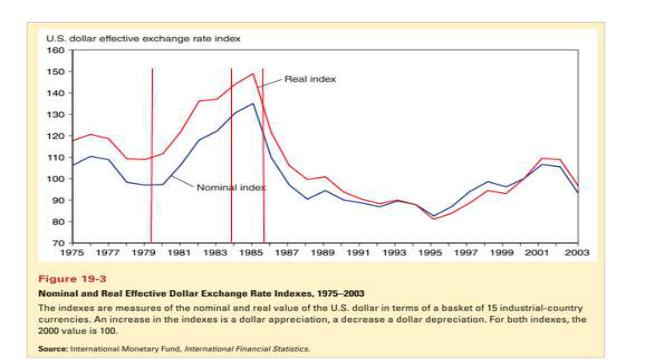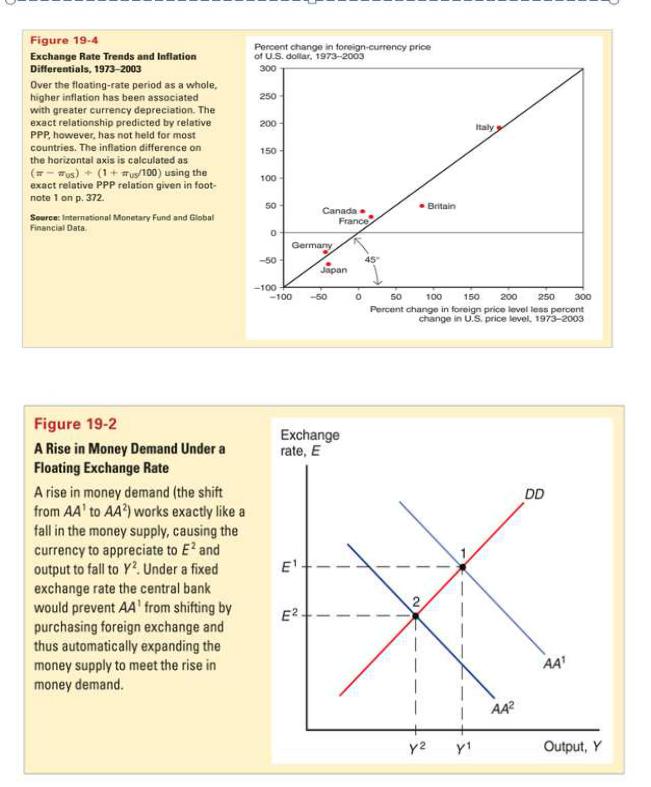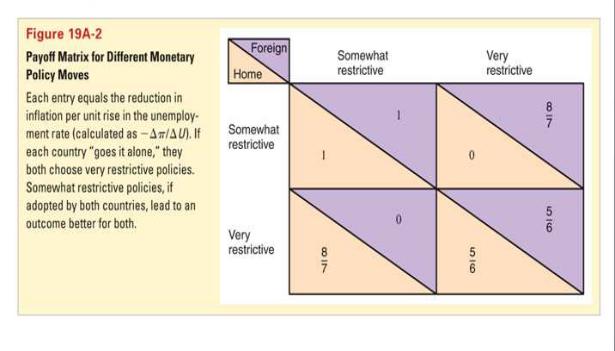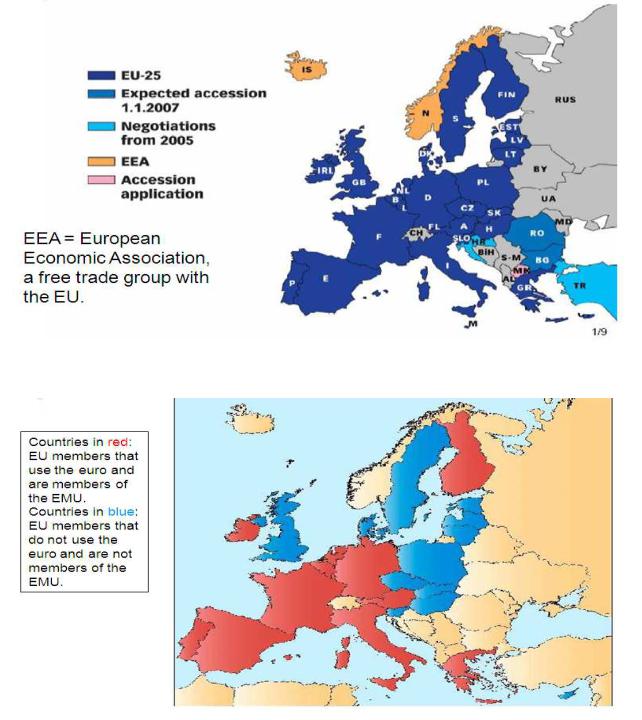
8855
.pdf
The articles allowed “surveillance” of members by o ther members to be sure they were playing fairly.
Since 1973
•Due to contractionary monetary policy and expansive fiscal policy in the US, the dollar appreciated by about 50% relative to 15 currencies from 1980–1985.
This contributed to a growing current account deficit by making imports cheaper and US goods more expensive.
To reduce the value of the US $, the US, Germany, Japan, Britain and France announced in 1985 that they would jointly intervene in the foreign exchange markets in order to depreciate the value of the dollar.
The dollar dropped sharply the next day and continued to drop as the US continued a more expansionary monetary policy, pushing down interest rates.
Announcement was called the Plaza Accords, because it was made at the Plaza Hotel in New York.
•After value of the dollar fell, countries were interested in stabilizing exchange rates.
21
US, Germany, Japan, Britain, France and Canada announced renewed cooperation in 1987, pledging to stabilize current change rates.
They calculated zones of about +/- 5% around which current exchange rates were allowed to fluctuate.
Announcement was called the Louvre Accords, because it was made at the Louvre in Paris.
•It is not at all apparent that the Louvre accord succeeded in stabilizing exchange rates.
Stock market crash in October 1987 made output stability a primary goal for the US central bank, and exchange rate stability a secondary goal.
New targets were (secretly) made after October 1987, but by the early 1990s, central banks were no longer attempting to adhere to these or other targets.
Price stability (low inflation) was also a main goal of the US central bank, not exchange rate stability.
•Many fixed exchange rate systems have nonetheless developed since 1973.
European monetary system and euro zone (studied in chapter 20).
China fixes its currency.
ASEAN countries have considered a fixed exchange rates and policy coordination.
•No system is right for all countries at all times.
Interdependence of “Large” Countries
•Previously, we assumed that countries are “small” i n that their policies do not affect world markets.
For example, a depreciation of the domestic currency has no significant influence on aggregate demand, output and prices in foreign countries.
For countries like Costa Rica, this may be an accurate description.
•However, large economies like the US, EU, Japan, and China are interdependent because policies in one country affect other economies.
22
•If the US permanently increases the money supply, the DD-AA model predicts for the short run:
an increase in US output and income
a depreciation of the US dollar.
•What would be the effects for Japan?
an increase in US output and income would raise demand for Japanese products, thereby increasing aggregate demand and output in Japan.
a depreciation of the US dollar means an appreciation of the yen, lowering demand for Japanese products, thereby decreasing aggregate demand and output in Japan.
The total effect of (1) and (2) is ambiguous.
•If the US permanently increases government purchases, the DD-AA model predicts:
an appreciation of the US dollar.
•What would be the effects for Japan?
an appreciation of the US dollar means an depreciation of the yen, raising demand for Japanese products, thereby increasing aggregate demand and output in Japan.
•What would be the subsequent effects for the US?
Higher Japanese output and income means that more income is spent on US products, increasing aggregate demand and output in the US in the short run.
Chiang Mai Initiative
•In May 2000, ASEAN countries (Thailand, Brunei, Singapore, Philippines, Malaysia, Indonesia) plus China, South Korea and Japan met in Chiang Mai, Thailand.
They agreed to establish a network of financing for countries with balance of payments deficits.
They also considered coordinating monetary policies to fix their
currencies, or to create a common currency, in the future.
23
•ASEAN +3 countries wanted to avert another crisis like the one that occur in 1997.
Banks did not insure (hedge) against a decline in the value of domestic currency assets, making the value of assets less than the value of foreign currency liabilities after devaluations, leading to bankruptcy.
Banks expected that that the exchange rate would be fixed, but since 1997 banks expect greater volatility, and they have likewise insured against exchange rate risk.
Thus, one of the reason for having a fixed exchange rate (to avoid a banking crisis) has been already reduced by banks.
•Some countries are interested in developing export goods sectors (e.g., clothing, toys, computers).
These sectors would benefit from a low valued domestic currency, making exports cheap in foreign markets.
China currently has an undervalued currency; some policy makers in other countries may be interested in having a low valued currency at a fixed rate.
But capital controls are necessary to keep markets from buying domestic assets and selling foreign assets that might threaten the stability of a fixed exchange rate.
•But not all countries may want to follow a fixed exchange rate: central banks may target an inflation rate instead of an exchange rate, depending on macroeconomic policy and development goals.
Under a flexible exchange rate, central banks may respond to exchange rate fluctuations if they believe fluctuations are caused by short term flows of financial capital.
But long run changes in demand for exports (e.g., Korean toys) or in supply factors (e.g., productivity of labor in Korea) may not justify targeting a certain exchange rate, and the central bank may target
inflation or other macroeconomic goals instead.
24
•Each major ASEAN member contributed $150 million to a fund for balance of payments problems, and may withdraw up to 2 times their contribution in US dollar, euros or yen if the need arises.
In addition, bilateral loans maybe made between ASEAN and other participating countries.
But it is unclear whether the total fund of about US $ 1 billion is sufficient to maintain a fixed currency rate.
Summary
1.Arguments for flexible exchange rates are that they grant monetary policy autonomy, can stabilize the economy as aggregate demand and output change, and can limit some forms of speculation.
2.Arguments against flexible exchange rates are that they cause expenditure switching policies, can make aggregate demand and output more volatile because of uncoordinated policies across countries, and make exchange rates more volatile.
3.Since 1973, countries have engaged in 2 major global efforts to influence exchange rates:
1.The Plaza accord reduced the value of the dollar relative to other major currencies.
2.The Louvre accord was intended to stabilize exchange rates, but it was quickly abandoned.
4.Models of large countries account for the influence that domestic macroeconomic policies have in foreign countries.
25

Exchange Rates and Inflation
26

27

Chapter 20
Optimum Currency Areas and the European Experience
Preview
•The European Union
•The European Monetary System
•Policies of the EU and the EMS
•Theory of optimal currency areas
•Is the EU an optimal currency area?
•Other considerations of a economic and monetary union
What Is the EU?
•The European Union is a system of international institutions, the first of which
originated in 1957, which now represents 25 European countries through the:
European Parliament: elected by citizens of member countries
Council of the European Union: appointed by governments of the member countries
European Commission: executive body
Court of Justice: interprets EU law
28
European Central Bank, which conducts monetary policy, through a system of member country banks called the European System of
Central Banks
What Is the EMS?
•The European Monetary System was originally a system of fixed exchange rates implemented in 1979 through an exchange rate mechanism (ERM).
•The EMS has since developed into an economic and monetary union (EMU), a more extensive system of coordinated economic and monetary policies.
The EMS has replaced the exchange rate mechanism for most members with a common currency under the economic and monetary union.
Membership of the Economic and Monetary Union
•To be part of the economic and monetary union, EMS members must
1.first adhere to the ERM: exchange rates were fixed in specified bands around a target exchange rate,
2.next follow restrained fiscal and monetary policies as determined by Council of the European Union and the European Central Bank,
3.finally replace the national currency with the euro, whose circulation is determined by the European System of Central Banks.
Membership of the EU
•To be a member of the EU, a country must, among other things,
1.have low barriers that limit trade and flows of financial capital
2.adopt common rules for emigration and immigration to ease the movement of people.
3.establish common workplace safety and consumer protection rules
4.establish certain political and legal institutions that are consistent with the EU’s definition of liberal democracy.
29

Members of the European Union
EU/EMS Members of the Economic and Monetary Union (EMU)
Why the EU?
•Countries that established the EU and EMS had several goals
1.To enhance Europe’s power in international affairs: as a union of countries, the EU could represent more economic and political power in the world.
30
